Tuesday, July 19. 2011
The Weather Bank
Via BLDGBLOG
-----
A slideshow over at National Geographic features this image by photographer Ian Wood, showing, in the magazine's own words, "what might be called extreme Inca landscaping."
 [Image: The weather bowl at Moray, Peru; photo by Ian Wood/Alamy, courtesy of National Geographic].
[Image: The weather bowl at Moray, Peru; photo by Ian Wood/Alamy, courtesy of National Geographic].
"Three enormous pits, each with beautifully curved sides that staircase down like the interiors of titanic flowerpots have been carved out of the earth to depths of up to 100 feet and more," the magazine adds. They are like Indian stepwells—only they concentrate thermal gradients—and this affects the local weather: "Air temperatures between the top and bottom layers can differ by more than 20 degrees, which has led some researchers to theorize that Moray was an Inca agricultural site where experiments on crops were conducted."
It's a site of experimental agriculture fueled by an act of microclimatic terrain deformation.
So does this mean that the weather at Moray should be subject not only to meteorological analysis, but to archaeological interpretation? The site you're excavating seamlessly continues into the sky above it, turning the weather itself into an historic artifact—a whole new spin on paleotempestology.
But is the weather created by an historic site also part of that historic site? If so, should ancient microclimates such as these be subject to material preservation? Put another way, if there were a Museum of Ancient Microclimates, how would you design it and what would the visitor experience be?
Imagine a whole constellation of these oversized weather pits, meanwhile, distributed throughout the Andes, all interacting with and augmenting one another, producing continent-scale storm systems—and imagine being hit by a summer downpour, or sitting calmly throughout the winter as blizzards rage just one valley over, knowing that the atmospheric events around you are really long-lasting cultural gifts of the people who lived there centuries before. Weather designed by your ancestors still rages around you today.
 [Image: From Sietch Nevada by Matsys; renderings by Nenad Katic].
[Image: From Sietch Nevada by Matsys; renderings by Nenad Katic].
Superficially, I'm reminded of the hexagonal "water storage banks" of Sietch Nevada, a speculative design by the San Francisco-based firm MATSYS. While the resemblance doesn't go much beyond form, this comparison lets us borrow MATSYS's idea of a water bank and, thus, reinterpret the Incan site at Moray as a kind of weather bank, storing temperatures and headwinds year round. It is a space to store climates in.
Extrapolating wildly from this, if the rise of the Himalayas radically altered the earth's climate by changing weather patterns for thousands of miles in all directions, then perhaps we can imagine a scenario in which a network of artificial pits in the Andes begins to affect the jet stream, plunging Australia into drought and pushing rain far north into Mexico—and that, in turns out, is those pits' very purpose, having been excavated by scientifically advanced, self-styled weather warriors more than 600 years ago for reasons still unclear today. Groups of elders would get together in the dark, sitting around their pits in tight circles as the winds picked up, burning incense, singing tales, hurling storms like artillery into the central Pacific.
(Thanks to Marilyn Terrell for the heads up!)
Wednesday, July 06. 2011
Coal warehouse
Vias TreeHugger
-----
Just a picture extracted from this article. A huge building for (coal) hills!
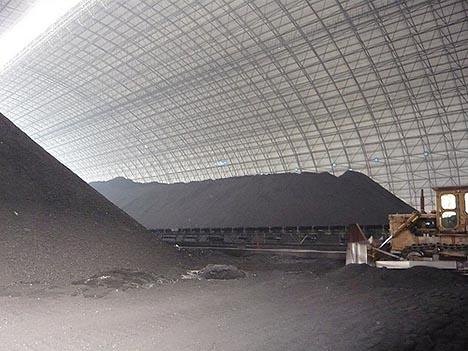
The article on TreeHugger is also interesting as it stipulates that intensification of coal extraction in China not only contributed to more CO2 emssions during the last 10 years, but also to the rejection of a lot of thin particles in the air. As a sort of side effect geoengineering technique, guess what? it also contributed to the cooling of the atmosphere...
Thursday, May 19. 2011
DETAIL Magazine: Digital Processes
by Christopher Henry

I recently read Detail Magazine’s latest issue about Digital Processes. The issue is divided into three parts. The first part deals with digital planning technologies that include mapping techniques for analysis, terrestrial laser scanning, and geographic information systems among others. The second section delves into digital production technologies such as CNC laser cutting, hot wire cutting, and jointed-arm robotics. The final piece brings these together by showcasing six projects that utilize these technologies. In its totality, the issue is a good overall look at the present and future opportunities digital technology offers the profession.
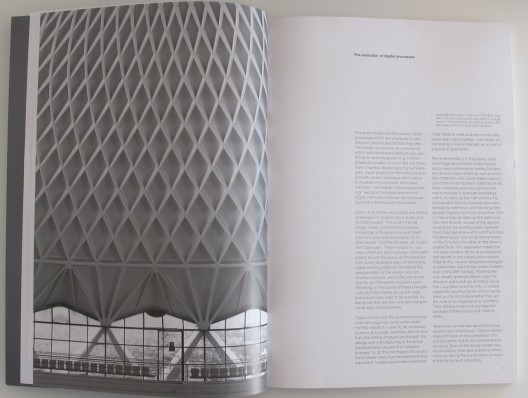
Contents
7 Introduction: The Evolution of Digital Processes
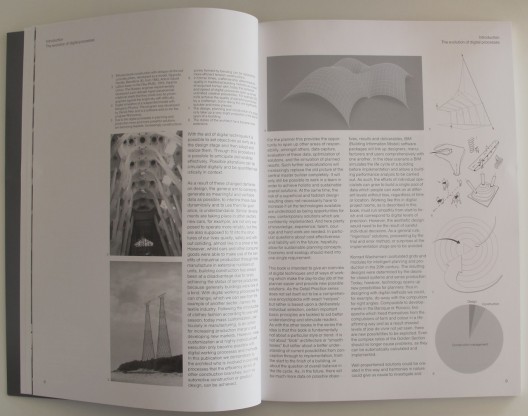
Digital Planning Technologies

14 Geographic Information Systems
16 Analysis Techniques—Mapping
18 Simulation and Optimization
21 Computer-aided Architectural Design (CAAD)
24 Rule-Based Planning—Parametrics
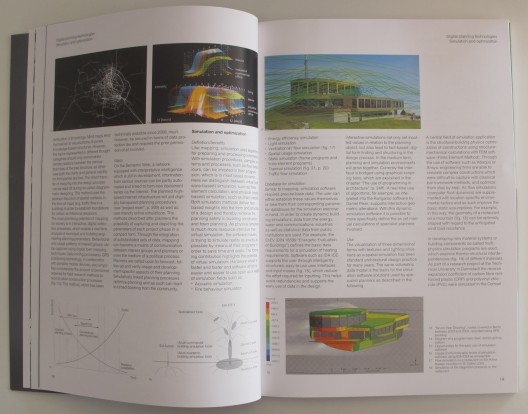
27 Digital Capture—Terrestrial Laser Scanning (TLS)
29 Project Room—The Transparent Project
33 Digital Interfaces in Construction
41 Legal Challenges in the Context of Digital Planning Processes
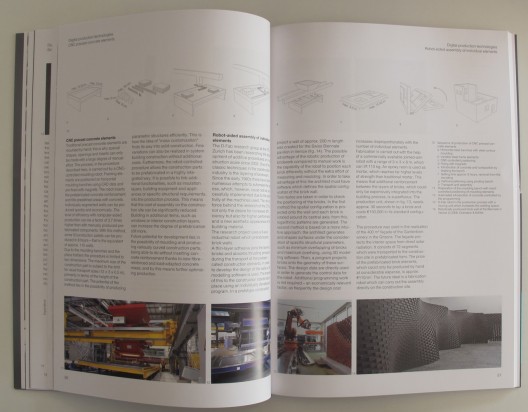
Digital Production Technologies
46 Generative Procedures
46 Rapid Procedures
50 CNC Precast Concrete Elements
50 Robot-aided Assembly of Individuals Elements
52 3D Printing on a Large Scale
54 Subtractive Procedures
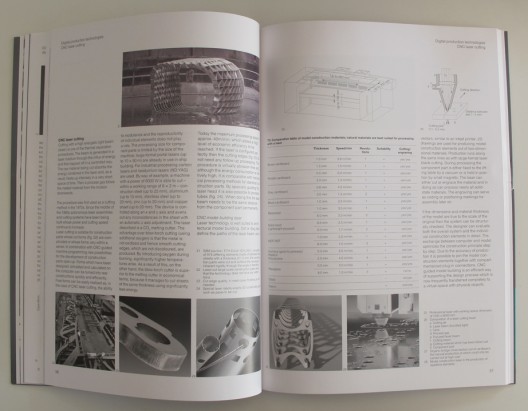
56 CNC Laser Cutting
58 CNC Jet Cutting
59 CNC Hot Wire Cutting
60 CNC Milling
61 Jointed-arm Robotics
62 Forming Processes
64 CNC Bending Edges
66 CNC Punching and Nibbling
68 Pressure Forming
Project Examples
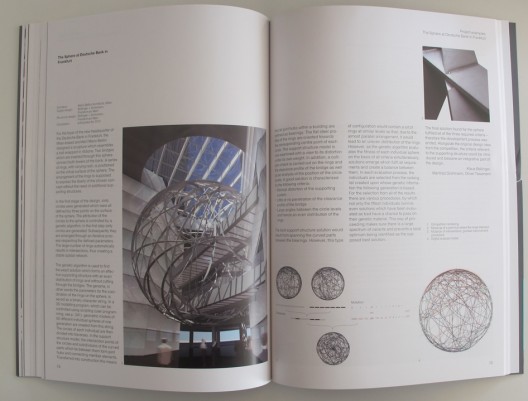
72 Digital Generation of a Supporting Structure
74 The Sphere at Deutshe Bank in Frankfurt
76 Pedestrian Bridge in Reden
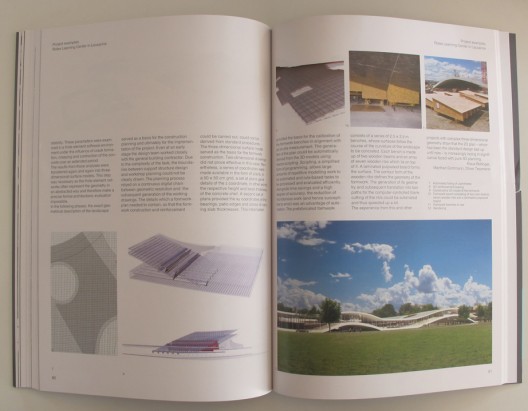
77 Rolex Learning Center in Lausanne

82 Hungerburg Funicular in Innsbruck
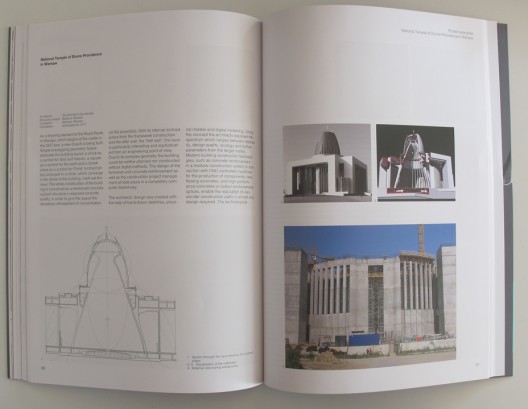
86 National Temple of Divine Providence in Warsaw
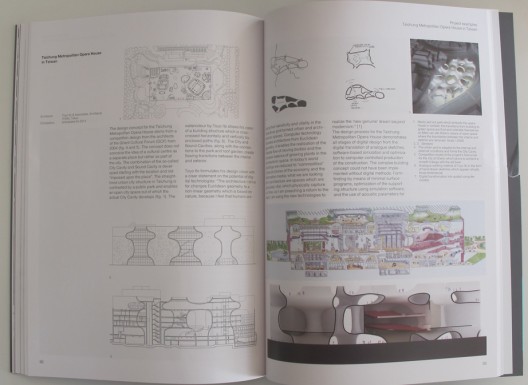
92 Taichung Metropolitan Opera House in Taiwan
Appendix
105 Glossary
107 Literature: Reference Books and Articles
108 Manufacturers, Companies and Academic Institutions
109 Picture Credits
110 Index
Authors:
Moritz Hauschild
Rüdiger Karzel
Co-Authors:
Martin Berchtold
Klaus Bollinger
Manfred Grohmann
Holger Heilmann
Philipp Krass
Arne Künstler
Martin Manegold
Heike Matcha
Shozo Motosugi
Christoph Motzko
Oliver Tessmann
Axel Wirth
Staff:
Ante Ljubas
Sara Darvish
Christoph Kühne
Editorial Services:
Cornelia Hellstern, Nicola Kollmann, Eva Schönbrunner
Editorial Assistants:
Katinka Johanning, Peter Popp, Verena Schmidt
Cover: Paperback
Pages: 111
ISBN: 978-3-0346-0725-4
Thursday, April 14. 2011
The World's Largest Concentrated Solar Plant Is Coming to California
Via GOOD
-----
by Ben Jervey
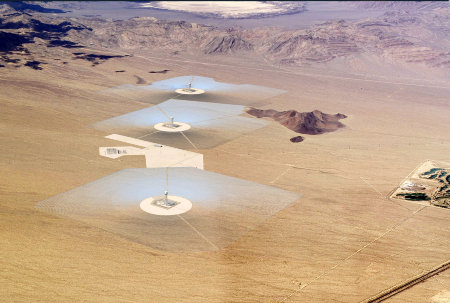
As I've said before, concentrated solar power (the "other" kind of solar—not photovoltaic panels) is a core component of any carbon-free energy future. This week, the United States is one giant step closer to plugging in the world's largest concentrated solar power plant—Brightsource's Ivanpah plant—which will pump out a massive 392 Megawatts of clean, solar energy in the Mojave Desert as soon as 2013. A rendition of the enormous project is above.
The project took a big leap from business plan to reality this week with two serious funding deals. First, Google announced its largest energy investment ever—placing a $168 million bet on Brightsource. The same day, the Department of Energy finalized a whopping $1.6 billion in loan guarantees for the project. "Today's announcement is creating over 1,000 jobs in California," said Energy Secretary Steven Chu, "while laying the foundation for thousands more clean energy jobs across the country in the future."
Not familiar with this core clean energy solution? Here's how I described it a couple years ago:
Whereas photovoltaic panels directly convert sunlight into an electric current, concentrated solar uses the sun's heat energy itself to generate power. [...] The intense heat boils the water, which creates steam. The steam spins a turbine, and-voila!-electricity is generated. Under optimum conditions, the plant can churn out 20 megawatts of juice, enough to power 10,000 homes.
Here's an illustration from our graphics team from a few years back:

So just how big is the potential for concentrated solar? A recent study found that 1,000 square miles of the Mojave Desert devoted to CSP could produce enough energy to power the entire country. On a grander scale, less than one percent of the world's deserts could power the whole world, if transmission lines could accommodate the electricity. In other words, plants like Ivanpah can absolutely replace coal-burning power plants in sunny areas.
Here's Brightsource's test site in Israel, where it's proving the technology.
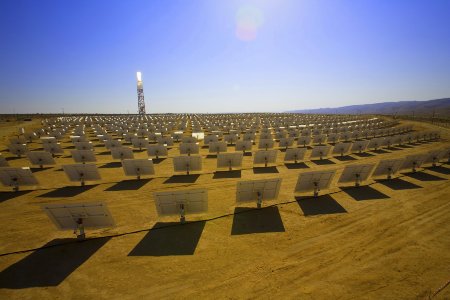
I found it interesting that the Department of Energy and Google made these funding announcements on the same day. Such public-private cooperation seems to represent the best path forward for clean energy absent any federal legislation or mandate.
Wednesday, March 23. 2011
Norman Foster Recreates Buckminster Fuller’s Dymaxion Car
Via ArchDaily
-----
by Kelly Minner
“I was privileged to collaborate with Bucky for the last 12 years of his life and this had a profound influence on my own work and thinking. Inevitably, I also gained an insight into his philosophy and achievements,” shared Lord Norman Foster.
Recreating the legendary futuristic Dymaxion Car, Foster’s No. 4 version was a lengthy and expensive two year project, but was obviously a labor of love. Buckminster Fuller’s futuristic three wheeled car was brief, with a mere three actually built. Incredibly efficient the streamlined body with long tail-fin averaged 35 miles to the gallon and could achieve 120 mph. The Zeppelin inspired design with a V8 Ford engine was intended to fly as well, Fuller’s vision of revolutionizing how people traveled.
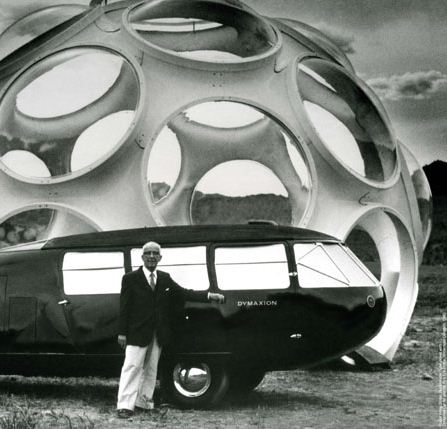
Referencing some 2,000 photographs as a starting point, Foster was also able to borrow the only surviving Dymaxion Car (No. 2) from the National Automobile Museum in Reno, Nevada, with the promise of creating a much needed new interior for the car. Recreating the interior for the new car (as well as for No. 2) ended up being more of a historic approximation relying primarily on images of the original Dymaxion Car, tracking down (if any) original components, and building replicas from scratch.
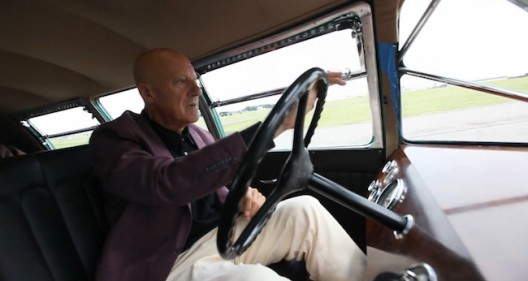
Norman Foster driving his Dymaxion Car
The completed Dymaxion Car was featured in an exhibition of the work of Buckminster Fuller curated by Foster in Madrid last September. Our coverage of the exhibition can be found here.
Foster shared that, “driving the Dymaxion is a revelation. There’s something in that feel as you wind the steering wheel and increase the power. The horizon just kind of spins around the cockpit. It’s quite extraordinary. And it’s a showstopper. Even now, seventy-eight years later, it still has the power to stop people in their tracks.”

© Gregory Gibbons, Courtesy Ivorypress
Metropolis Mag Q&A: Norman Foster and the Dymaxion Car
By Martin C. Pedersen
What inspired you to recreate Bucky’s famous Dymaxion Car?
Bucky is never far from my thoughts. We collaborated on projects for the last twelve years of his life. When I was awarded the Royal Guild Gold medal in London, he gave the talk. At that point we had decided to do houses for each other. So he came over and we talked about the project. He gave the talk and then he left for America, off to see his terminally ill wife, Ann, in the hospital. On arrival, he had a fatal heart attack at her bedside and she died thirty six hours later. Curiously, on that trip to England, he said to me, “You know, Norman, anytime, I can pull the plug.” I guess that’s when he pulled the plug. He got there and realized that his wife wasn’t going to recover.
Why remake the Dymaxion now?
It was an interesting exercise for us. Like everything else he did, the car was pure Bucky. He was a friend of Henry Ford, which insured that he would get Ford parts for 30 percent of their true cost. So he took the flathead v8 engine, the wheels, the steering wheel, the transmission, and turned it 180 degrees. So you can make a like-by-like comparison between the Dymaxion car and Fords from 1913 to 1933. But the Dymaxion was three times the volume. It had the potential of taking up to eleven rather than four. It was significantly faster, and consumed half the fuel. It was truly doing more with less.
In recreating the new car, where did you draw the line between faithfully executing those original plans and drawings, and making improvements to them?
The #4 car is not a replica of the #3 car, but we did replicate the engine, the Studebaker ignition, the Ford wheels and steering wheel. The only thing that’s not completely authentic and original is the hand break. The original didn’t have one, for some strange reason.
I saw the surviving Dymaxion at the Whitney show a few years back. The interior had badly deteriorated. Your team must have done a great deal of detective work to recreate the interior.
Yes, unbelievable. Fortunately, we know the people at Stanford well, where the archive is. And the people we chose to do the restoration work were also extraordinarily incredible at research. We generated a huge body of knowledge. People would email and call in. We developed a great archive and out of that produced a book on the car. The book is tiny, tiny tip of the iceberg on all the material we generated.
It took two years to complete this. How much did the project cost?
I’d rather not talk about that. The true answer is an arm and a leg, a lot of money. It took twice as long and cost significantly more than I had budgeted for it. Of course, that’s everybody’s story with any classic restoration. Everyone underestimated the task. But then, it was a group of perfectionists involved, and it’s an absolutely stunning vehicle.
What is the car’s relevance to automobiles today?
First of all, the maxim of doing more with less is more urgent and imperative today than it’s ever been. In a way the Dymaxion was the classic people-mover before its time. The three wheel configuration caused a lot of debate. Was it a stable configuration? Not withstanding the size. It does produce this extraordinarily dramatic turning circle. There is a vintage movie of Bucky pirouetting the car around this policeman. It just nudges the policeman as it circles around him. I’ve driven it in an airfield and explored exactly that capability. There’s something in that feel as you wind the steering wheel and increase the power. The horizon just kind of spins around the cockpit. It’s quite extraordinary. And it’s a show stopper.
What’s the ride like aerodynamically?
It’s not soft, but it’s amazingly cushioned. It’s more like a boat. Of course it was co-designed with Sterling Burgess, the America’s Cup-winning yacht designer. So the ride is quite remarkable. It has a lot of the characteristics of 1930s cars: the break pressure is quite heavy, but that’s normal for vehicles of that period. It has its British MOT and British plates. It is road legal, but since it has precious value I’m not sure that I’m about to drive it on a narrow country lane.
What can it do on a straight away?
You’d be very conformable on legal road speed limits. Natural caution on my part, possibly a side affect of advancing years, introduces a degree of hesitation.
Would it comfortably do 100 kph [sixty miles per hour]?
Oh, yes. It’s also a precursor to something called the D45. The D45 was an urban car, seating five, with the same three-wheel configuration. But the drawings of that demonstrate that it had better stability at speed because the rear wheel extends out to increase the wheel base. We did a series of studies and developed an absolutely beautiful film. We showed that as part of our Bucky exhibition in Madrid. It is quite amusing. The Dymaxion comes out of a 1930s garage in New York and drives past all these old cars. It goes past the Hearst Building, which of course was still relatively new, then crosses the river and goes into a tunnel. It comes out the other side in present day New York. It still looks like something out of a science fiction movie.
It’s interesting how you and Nicholas Grimshaw and Richard Rogers were all drawn to Bucky in your formative years. What drew all of you into his orbit?
It was his philosophy, his optimism, his belief in friendly clean technology that would enable the species to survive if they used their intelligence. There were other influences during that time. But I never dreamed that a few years later I’d end up being approached by Bucky to collaborate with him on projects and for it to become such a close relationship.
You’ve talked about Bucky to younger audiences. Do his ideas connect with them?
I think they really resonate. He empowered a generation. It’s not too much of an exaggeration to say that he triggered the green movement. Whether anything has made enough of an impact can be debated, but certainly the environmental movement is rooted in Bucky. He has tremendous appeal and relevance to younger generation architects and environmentalists today and in a way, I feel that he’s not recognized the way that he should be. He’s been much more widely understood in Europe. I don’t know how you feel, but I don’t think he’s ever been truly understood in America.
Friday, March 11. 2011
Seadromes… On Islands and Megastructures
Via dpr-barcelona
-----

Seadrome 1/300 scale model [1922] by Edward Robert Armstrong
A seadrome, concept developed by Edward Robert Armstrong, is an enormous floating islands of steel and concrete, to cover 100 or more acres and be anchored at intervals across the Atlantic. According to Armstorng’s design, it would be rise 70 feet (21 m) or more above the surface of the ocean by tubular columns that would allow waves to pass underneath. We can read the following description:
A seadrome would be a “floating landing deck,” essentially an anchored, stormproof airport and refueling station. It would ride high above the waves, moored at one end so as to trail the wind [thus always staying in the best position for landings], and be big enough to permit the landing and takeoff of most planes. It would be supported 70 feet or more above the surface by tubular columns that would allow waves to pass through underneath. The columns would terminate in ballast tanks 100 feet below the surface, where they would be stable, since waves are surface disturbances only. Armstrong said eight of them, “anchored to the bottom of the Atlantic, at intervals of approximately 350 miles,” would be enough to reach [from the US to] Europe.
We can see how engineer had influenced the avant-garde and radical architecture. If now we can see proposals to reuse abandoned oil rigs or some other that are based on the idea of recycling ships and marine structures, some of the designs of the 1960s and 1970s were based on this idea of seadromes as floating islands orfloating cities. That’s why we found really provocative to talk about the seadromes and how they have been “adopted” by different disciplines, including architecture.

Floating Ocean Airports [Feb. 1934]. Source: Modern Mechanix

Project Habakkuk. Render. Source: Mondolithic
Time magazine wrote on November 27, 1933:
A perennial gift to Sunday feature editors for the last five years has been the Armstrong Seadrome, vividly imaginative project for a chain of floating airports across the Atlantic. The perfect publicity subject, it offered serious readers masses of data on construction of huge platforms, stabilized high above the waves by means of weighted pillars, on problems of anchorage, navigation, operation, economics.
The seadrome idea was also the starting point of another utopian project, the Habakkuk by Geoffrey Pyke, based on a scheme to assemble an elite unit for winter operations in Norway, Romania, and the Italian Alps, which is basically an aircraft carrier out of pykrete [a mixture of wood pulp and ice]. Pyke envisioned ships as vast and solid as icebergs. But, as we can read at Cabinet Magazine, the Habbakuk was never built anyway. Land-based aircraft were attaining longer ranges, U-boats were being hunted down faster than they could be built, and the US was gaining numerous island footholds in the Pacific—all contributing to a reduced need for a vast, floating airfield.
The idea of the seadrome as a floating island just takes us to analyze how they were part of the inspiration of some floating megastructures. Reyner Banham pointed on his book Megastructure: Urban Futures of the Recent Past that mostly all of the first megastructure designed on the first years of the avant-garde movement were inspired by piers and freight platforms, such as the Scheveningen pier in the Netherlads or the Santa Monica pier in Los Angeles. So we can see that the relationship with the idea of floating cities was there, since the earlymegastructuralist projects.
But talking about more recent projects, we can see the evident similarities from this airport designed by M. Lurcat for the middle of the river Seine, in the midst of Paris in 1932:
To the Megafloat project in Japan, currently under construction:
So, the interesting idea here is to discuss if all this seadromes and floating islands can become new territories to be inhabited. Hernán Diáz recently wrote for the issue Islands on Cabinet Magazine an interesting article called A Topical Paradise. Here he quoted the poem “islands” written by W. H. Auden, pointing:
Auden’s inversions suggests that, wether solid or liquid, an island embodies a focus of difference. Every segment in the circumference of an island ceaselessly insist against its surroundings, exerting a centrifugal force. Not only because “it is as though the island had pushed its desert outside”, as Deleuze writes in Desert Islands, but also because it is repelling the desert that pushes in.
After this reflections, we just think: What will come next… Islands in space inspired by seadromes? It seems that we’re going on that way:

Cloud Base. Source: GoogleImages
“Far off like floating seeds the ships
Diverge on urgent voluntary errands,
And this full view
Indeed may enter
And move in memory as now these clouds do,
That pass the harbour mirror
And all the summer through the water saunter.”
- “On This Island” by W.H. Auden
—–
Related readings:
- Desert Islands and Other Texts (1953-1974) [Semiotext(e) / Foreign Agents] by Gilles Deleuze
- Journey to the end of the night. Article about Seadromes
- The Floating Island. Article about Project Habakkuk at Cabinet.
- Soundtrack: On Islands by New Musik [spotify link]
“I will walk around the island. Look to see if there is something to eat. Build a house from straw and wood. Carve a bow and arrow to hunt wild pigs and tigers. Look for a man to fall in love with. If I don’t find him, I’ll make one from clay and mud [...] I don’t think I will make art on a desert island.”
- Keren Cytter, Cabinet Magazine [2010]
Monday, March 07. 2011
L’Islande et l’Europe reliés par un câble électrique
Après avoir paralysé les cieux européens avec d'épaisses volutes de cendres volcaniques l'an dernier, la grande île de l'Atlantique nord cherche désormais à exploiter les effets favorables de ses volcans en vendant à l'Europe de l'énergie géothermique tirée des eaux bouillantes de son sous-sol et de l'énergie hydrothermique de ses glaciers.
Pour ce faire, le groupe public d'énergie Landsvirkjun veut mettre en place un long câble électrique sous-marin afin de relier l'Islande à l'Europe. "Nous étudions entre autres le pays de destination. Les pays potentiels sont le Royaume-Uni, la Norvège, les Pays-Bas ou l'Allemagne", selon Ragna Sara Jonsdottir, porte-parole du groupe public d'énergie Landsvirkjun. Suivant sa destination finale, le câble mesurerait entre 1200 et 1900 kilomètres de long. "Ce serait le plus long câble sous-marin au monde", souligne la responsable.
Bientôt une décision
"Ce projet a commencé l'an dernier et la phase de recherches devrait être terminée d'ici la fin de cette année. Nous en saurons alors plus sur sa faisabilité", a déclaré la porte-parole, qui table sur une possible décision d'ici 4 ou 5 ans.
Le projet table sur un objectif d'exportation de 5 térawattheures (5 milliards de kilowattheures) par an, indique-elle. Cette production représente, au cours actuel de l'électricité en Europe, environ 250 à 320 millions d'euros d'exportations chaque année suivant les pays. Cela équivaut à la consommation de 1,25 million de foyers européens.
Remède à la crise
"L'idée est de répondre à la demande en Europe aux heures de pointe, ainsi qu'en partie en demande de base", explique Ragna Sara Jonsdottir, sans vouloir donner d'estimation du coût du projet. Landsvirkjun, qui appartient à l'Etat islandais, produit déjà environ 75% de l'électricité islandaise.
L'Islande, qui a traversé une grave crise économique après l'effondrement fin 2008 de ses banques jadis florissantes, cherche de nouvelles ressources pour relancer son économie, qui repose désormais principalement sur la pêche.
afp/jbu
Related Links:
Weather Architects of the Year 2050 A.D.
 [Image: "Whirlpool" (1973) by Dennis Oppenheim].
[Image: "Whirlpool" (1973) by Dennis Oppenheim].Artist Dennis Oppenheim's "Whirlpool" project, from the summer of 1973, sought to create an artificial tornado on the bed of a dry desert lake in Southern California. It was intended as a "3/4 mile by 4 mile schemata of tornado," the above image explains, "traced in [the] sky using standard white smoke discharge from aircraft."
As the Telegraph describes it:
- Employing one of [Oppenheim's] characteristic quasi-scientific methods, the piece was created by issuing radio instructions to an aircraft which discharged a liquid nitrogen vapor trail. The aircraft began by flying in revolutions measuring three quarters of a mile in diameter. Subsequently the pilot was instructed to repeat this manoeuver but, with each revolution, he was made to reduce the size of the diameter of the circle and lose height—and it is no mean feat controlling a plane according to these specifications. The operation had to be repeated three times before the desired whirlpool effect was achieved.
In a short story called "The Cloud-Sculptors of Coral D," J.G. Ballard envisions a tropical atoll where the residents have learned to "sculpt" clouds in the sky, listening to Wagner over loud speakers and using specially engineered gliders and flying techniques.
"Lifted on the shoulders of the air above the crown of Coral D," Ballard writes, "we would carve seahorses and unicorns, the portraits of presidents and film stars, lizards and exotic birds. As the crowd watched from their cars, a cool rain would fall on to the dusty roofs, weeping from the sculptured clouds as they sailed across the desert floor towards the sun."
They are part aesthetic object, part weather system.
 [Image: "Column" by Anthony McCall, courtesy of Creative Review].
[Image: "Column" by Anthony McCall, courtesy of Creative Review].
Both of these came to mind this weekend when I read that artist Anthony McCall is planning to create something called "Column" in Liverpool, to coincide with the London 2012 Olympics. It will be "a spinning column of cloud a mile high," as Creative Review describes it, "visible across the North West region throughout the Olympic year."
Made of cloud and mist, this "swirling micro-climate" will be "created by gently rotating the water on the surface of the Mersey and then adding heat which will make it lift into the air like a water spout or dust devil."
We'll have to see how it actually works out, of course, but the idea that cities might soon deploy large-scale specialty weather-effects—that is, permanent climatological megastructures—instead of, say, Taj Mahals or Guggenheim Bilbaos as a way of differentiating themselves from their urban competition is a compelling one.
The future weather-architects of 2050 A.D. In-house climatologists spinning noctilucent clouds above Manhattan.
Personal comment:
Some comments and additionnal references by Geoff Manaugh about McCall's "Column" project.
Monday, January 17. 2011
A Clear Sky
Via Next Nature
-----

Remember the beginning of 2010, when the Eyjafjallajokull volcano erupted, throwing huge amounts of ash into the air, thousands of flights have been canceled across Europe due to fears that ash could turn into molten glass within a hot jet engine, crippling the aircraft. This picture was taken during and after the flight ban at the same location.
Personal comment:
Are planes in fact among the first unspoken geo-engineering devices? Cloud generators?
Tuesday, November 30. 2010
Wildlife crossing
Via Archinect
-----
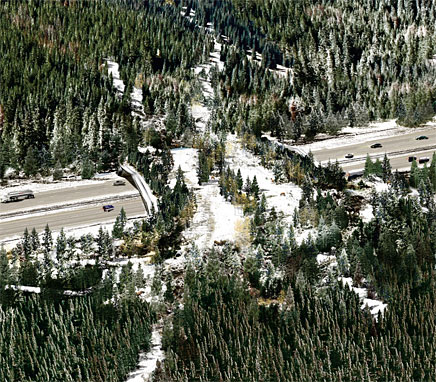
Today, the ARC International Wildlife Crossing Infrastructure Design Competition unveiled its five finalist designs for a next generation wildlife crossing at West Vail Pass, Colorado. The competition is intended to solve the problem of ensuring safe travel for humans and wildlife. Collisions between vehicles and wildlife have increased by 50 percent in the past 15 years threatening human and wildlife safety, and costing Americans $8 billion dollars annually. Bustler
fabric | rblg
This blog is the survey website of fabric | ch - studio for architecture, interaction and research.
We curate and reblog articles, researches, writings, exhibitions and projects that we notice and find interesting during our everyday practice and readings.
Most articles concern the intertwined fields of architecture, territory, art, interaction design, thinking and science. From time to time, we also publish documentation about our own work and research, immersed among these related resources and inspirations.
This website is used by fabric | ch as archive, references and resources. It is shared with all those interested in the same topics as we are, in the hope that they will also find valuable references and content in it.
Quicksearch
Categories
Calendar
|
|
July '25 | |||||
| Mon | Tue | Wed | Thu | Fri | Sat | Sun |
| 1 | 2 | 3 | 4 | 5 | 6 | |
| 7 | 8 | 9 | 10 | 11 | 12 | 13 |
| 14 | 15 | 16 | 17 | 18 | 19 | 20 |
| 21 | 22 | 23 | 24 | 25 | 26 | 27 |
| 28 | 29 | 30 | 31 | |||


